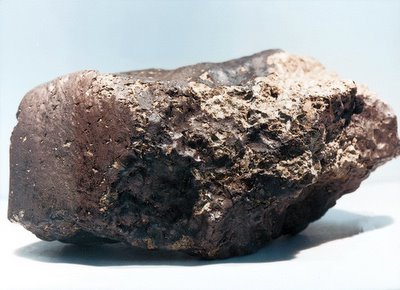
It Came From Outer Space
Reviewed by Charles Seife
The Washington Post
2-26-06
On Aug. 7, 1996, the war of the worlds began in earnest. At a press conference in NASA's Washington, D.C., headquarters, researchers announced that a craggy lump of rock teemed with evidence of ancient Martian life. If true, E.T. had been found.Reviewed by Charles Seife
The Washington Post
2-26-06
Even if E.T. were friendly, the scientific atmosphere surrounding the discovery of the rock certainly wasn't. However, it seems that E.T. wasn't friendly. The Mars meteorite press conference sparked a vicious clash between two increasingly entrenched scientific camps. Critics immediately started discrediting the research, and the opposing groups battled for years about the true meaning of the extraterrestrial rock. Nearly a decade later, the wounds haven't healed. The fights were brutal because the stakes were so high.
Kathy Sawyer, who covered outer space for the Washington Post for 17 years, adeptly tells the saga in The Rock From Mars . However, the subtitle of her book is somewhat misleading; the story is more "Rashomon" than The Hound of the Baskervilles . There's no "Aha!" moment, no final answer to a burning mystery, no way to know definitively who's right and who's wrong. Good scientists and good journalists have looked at the same data and the same evidence and come to very different conclusions about whether or not the rock once harbored alien life.
This much is not in dispute: The rock is from Mars. It crashed down on the Antarctic ice about 13,000 years ago. The inside of the meteorite is dotted with fascinating, carbon-rich orange and black blobs. Upon closer inspection, the rock also contains little grains of iron-based material very similar to those found in some kinds of microbes. And it is full of wiener-like shapes that look like earthly bacteria, only smaller. NASA had found microscopic space sausages.

NASA geologist David McKay and his team of researchers took this data as substantial evidence that the rock was once teeming with Martian bacteria. Sawyer's book shines when she describes the team's intellectual struggles; she lovingly takes us into the scientists' laboratories and shows us how they finally reached their jaw-dropping conclusion. Sawyer then shepherds us from the intellectual leap to the political kerfuffle. Once McKay's group decided that they had evidence for ancient life on Mars, events quickly spun out of control. The scientific hypothesis began to take on greater and greater significance as it passed from the researchers to their superiors to NASA administrator Daniel Goldin -- who used the meteorite as a lever to give the struggling NASA a new mission -- and eventually to the White House.
However, the tale isn't all rosy. NASA's handling of the press conference alienated a number of scientists who felt that the researchers were being irresponsible with their claim of extraterrestrial life. In the following months and years, critics tore into the McKay team's conclusion and accused NASA of hyping the research. As the case for life in the Mars rock got fuzzier and fuzzier, the debate slowly sank away from the public gaze and away from the mainstream of scientific discourse.
Sawyer tells the story well, though her sympathetic portraits of NASA scientists and managers rely heavily on their points of view. This causes some problems with balance. From NASA's perspective, criticism of its work might well seem to be "belligerencies" or attacks laced with "sheer personal vitriol," as Sawyer describes them, but to scientists on the other side of the issue, their comments were justified scientific criticism of a high-profile study. Sawyer's prose tends to bolster one side and undermine the other, occasionally even bordering on ad hominem. For example, anti-Mars-life scientists are painted as needlessly pugnacious: one "antagonist" is "fonder of confrontation than most" while another "did not suffer criticism lightly."
It's excusable for a journalist to pick sides in a fight she's studied for so long. Less acceptable, though, is that Sawyer occasionally uses rhetoric to obscure opposing arguments rather than to elucidate them. In the 1990s, she writes, NASA began to present its best science results with "a series of news updates that included video and graphics, dissenting points of view, context, and a tilt toward English over jargon. The perceived success of this approach in attracting media coverage fed a current of indignation among those who considered such efforts unseemly."
This is unfair. Clarity and evenhandedness didn't infuriate NASA critics. The nay-sayers were angry because they thought that NASA's PR machine tended to hype scientific findings beyond reason when political stakes were high -- or, worse yet, that NASA tarted up subpar research and presented it to the public as first-rate science in order to justify otherwise unjustifiable spending. John Glenn's shuttle flight and the "world-class" laboratory work of the International Space Station are arguably prime examples. To some, so is the Mars meteorite.
NASA is in the midst, once more, of cost overruns and budget crises, and is desperately trying to redefine itself. As the agency presents fascinating news from Mars, Saturn and elsewhere in the universe, seeing how it gets its hands dirty politicizing science would provide an interesting counterweight. Even though this might disappoint some die-hard NASA fans, it would be worth seeing how space sausages are made.
More . . .
See Also: NASA's Next Leap in Mars Exploration Ready for Launch
Home
No comments :
Post a Comment
Dear Reader/Contributor,
Your input is greatly appreciated, and coveted; however, blatant mis-use of this site's bandwidth will not be tolerated (e.g., SPAM, non-related links, etc).
Additionally, healthy debate is invited; however, ad hominem and or vitriolic attacks will not be published, nor will "anonymous" criticisms. Please keep your arguments/comments to the issues and subject matter of this article and present them with civility and proper decorum. -FW